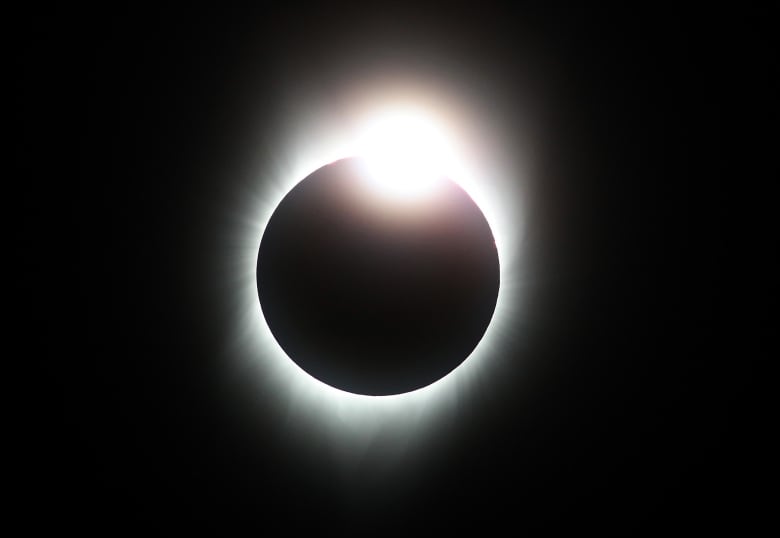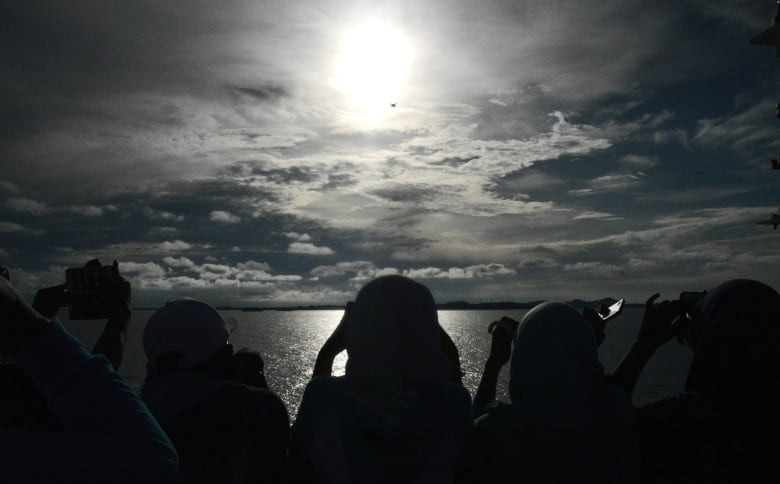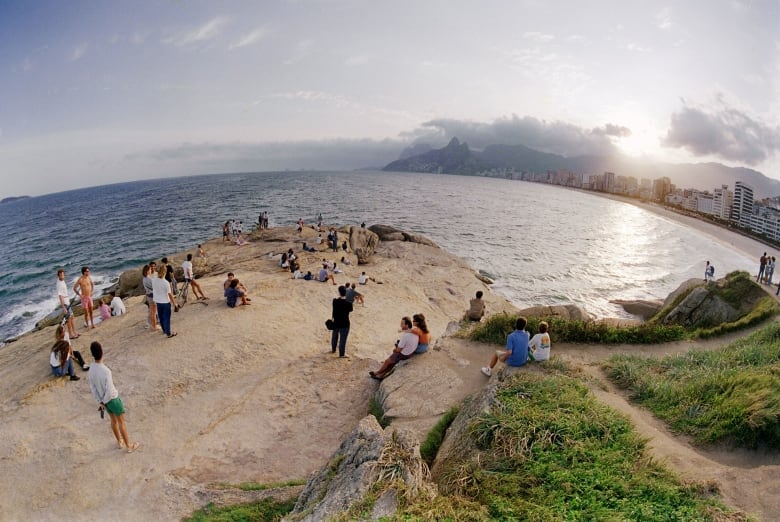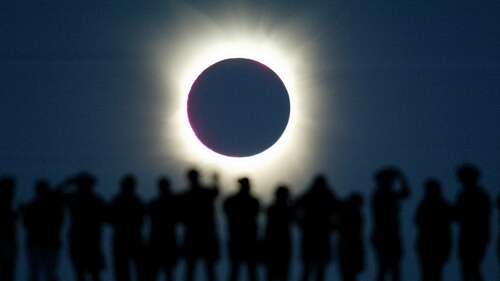This First Person column is written by Bob McDonald, host of CBC Radio’s Quirks & Quarks. On April 8, he will be in Kingston, Ont., to experience his seventh total eclipse.
My first eclipse was in 1977 on a ship in the Pacific Ocean, 1,200 nautical miles off the coast of Mexico.
It was a special eclipse cruise involving two ships — one departing from Los Angeles, which I was on, the other departing from Florida and passing through the Panama Canal. The cruise included astronomy presentations from scientists until, on the third day out, the captain announced, “We’re here.”
The two ships met far out at sea in the path of totality. Everyone gathered on deck, as the ship slowly rolled on deep ocean swells. We waved to people on our sister ship not far away.
The tropical sun was hot. But as the moon began to pass in front of it, the temperature dropped to a comfortable level and the sky darkened to a deep cobalt blue. Totality arrived, transforming the sun into a silvery ring. Photographs just can’t capture the beauty of the sun’s corona, a wispy silvery glow with no definable edge, like the finest cat’s fur.
Then to our surprise, the planets Mercury and Venus appeared as brilliant diamonds on either side, giving the appearance of a cosmic necklace in the sky with the sun as a pendant in the middle.
I was hooked.

A humbling experience
There is a saying among eclipse chasers, that “Until you have seen a total eclipse, you haven’t seen an eclipse.” Having seen six in different locations around the world, I can verify that statement. It is a humbling experience, where the cosmos puts on a spectacular show — and we humans have nothing to do with it.
Earth is the only planet in the solar system that has total eclipses, where the sun is covered exactly by the moon. Our moon is 400 times smaller than the sun, while the sun is 400 times farther away, so they appear exactly the same size from the ground.
The path of totality — the only place to experience the whole effect of an eclipse — is very narrow. With each eclipse, it moves to a different part of the planet, making every one unique.
In 1979, people in Winnipeg and Brandon, Man., were treated to the full spectacle, but I was in Red Lake, Ont., visiting schools as an instructor from the Ontario Science Centre. We were clouded out but even with the clouds, it was a unique experience as the day suddenly went dark for a few minutes, as though some kind of giant alien mother ship had passed overhead.
Clouds are a major headache for eclipse chasers, who try to pick a spot along the path of totality that has the best chance of clear skies. You might think that, on the day of the eclipse, you’ll be able to move to a clear area, but roads are usually so congested that you can’t go anywhere.

Eclipses are a great excuse to travel and I have chased the moon’s shadow all over the planet.
In 1980 I joined another group of eclipse chasers on a trip to Africa, an adventure that included a safari across the Serengeti plains of Tanzania, where we drove among thundering herds of wildebeest and zebra with lions laying in wait.
The eclipse, seen from the base of Mount Kilimanjaro, was an extra bonus. Just before totality, when the sun was reduced to a thin sliver of light, I looked over toward a group of local people who had gathered to watch. Everyone appeared to have diamonds on their shoulders as their dark skin reflected the pinpoint sunlight.
In 1983, I bought a ticket to Indonesia, where we had an observing site on a beautiful beach on the island of Jakarta.

But the most spectacular eclipse I witnessed took place in 1991 at 4,200 metres, on the summit of Mauna Kea on the Big Island of Hawaii. This is where a group of giant telescopes take advantage of incredibly clear skies high above much of the Earth’s atmosphere; I was among a fortunate few journalists on the mountain.
That year was also when Mount Pinatubo in the Philippines erupted, sending a huge ash cloud into the stratosphere. We were worried it might obscure the eclipse. Instead, it provided an experience I have not seen again when, after totality, the high ash cloud acted as a giant screen, projecting the shadow of the moon slowly moving across the sky.
The U.S. was treated to an eclipse in 2017, so I travelled by motorcycle to Casper Wyo., for the event. The city held a three-day street festival with music, food, beer and vendors selling all kinds of memorabilia. This was the first eclipse event I’d attended with the general public rather than a bunch of science types. There was a party atmosphere ahead of time, but on the morning of eclipse day, everything went eerily quiet. Everyone was waiting for something to happen but weren’t quite sure what it was going to be like.
When totality washed over the crowd, emotional cheers, whistles, whoops and hollers rose to an amazing crescendo, but after it ended, everyone went quiet again, as if they were processing the powerful cosmic event as if it was some kind of religious experience.
The right place, the right time
Now it is Canada’s turn again.
On April 8, people in eastern Canada will have a unique experience that involves much more than the moon covering the sun. The whole environment changes, including the sky, air temperature, bizarre lighting effects, animal reactions, and a very emotional response from those in attendance.
When the moon begins to pass in front of the sun, people in the path of totality see what other parts of the country see through their protective eyewear — the sun turning into a crescent shape as it is partially covered by the moon.
Totality goes way beyond that. As the moon continues its steady progress across the sun, a darkness appears in the west. You can feel the temperature drop and the colours of objects around you become muted, turning into shades of grey. Even the chill in the air adds to the excitement that something big is about to happen.
As the last bit of sun is covered, the darkness descends like the lights in a theatre dimming before a movie begins. Birds take to the air, confused about the sudden appearance of darkness in the middle of the day.
CBC Ottawa’s Matthew Kupfer travels south to the U.S., to chase the best spots to watch the solar eclipse on April 8.
When totality arrives you can remove your eclipse glasses to see an amazing ring of silver where the sun used to be. The planets Jupiter, Venus and Saturn will emerge as diamonds on either side of the sun.
Then after a few minutes, a brightness appears in the west. Any clouds in that direction suddenly glow as the shadow of the moon passes by. Overhead, the brilliance of the sun’s face returns, peeking out from behind the moon’s edge. You look away, put your eclipse glasses back on, and watch the environment come back to normal.
The show is over but you feel a profound sense that forces beyond the Earth are at work producing a rare cosmic event that you were fortunate to be in the right place at the right time to witness.
May we all have clear skies!
Do you have a compelling personal story that can bring understanding or help others? We want to hear from you. Here’s more info on how to pitch to us.




